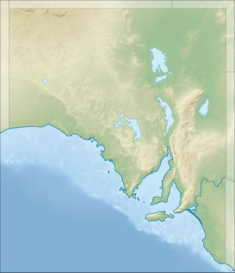|
Aroona Dam
Aroona Dam is a reservoir in the Australian state of South Australia located in the gazetted locality of Leigh Creek about 5 kilometres (3.1 mi) west of the locality’s town centre.[3] The dam consists of a concrete gravity dam of a height of 24 metres (80 ft) and a width of 236 metres (775 ft) which holds back a lake of a volume of 7,500 megalitres (1,650,000,000 imp gal) and which extends for a distance about 3.5 kilometres (2.2 mi) to the east of the dam wall.[2][4] The origin of its name is not mentioned in sources. However, the word ‘Aroona’ is listed in the official government place name gazetteer as the name of some geographic features either adjoining the dam or located within its extent. A mountain, Mount Aroona, is located in the ridge on the north side of the dam’s lake. A former water feature is now located “under the waters of the Aroona Dam” is named as the Aroona Waterhole as well as having the Adnyamathanha name of Arrunha Awi.[5][6][7] It was designed and built by the Electricity Trust of South Australia from 1952 to 1957 by damming the Arrunha Creek (also known as Aroona Creek in one source and as Scott Creek in another source) and using a labour force consisting mainly of immigrants engaged by contract for two-years and which peaked at a maximum of 160 men. Two shifts were scheduled during the winter months while concrete pouring was not conducted between November and March due to “extreme heat.”[2][8][9] Its original purpose was to supply the original town of Leigh Creek and the Leigh Creek Coalfield which was relying on water pumped from Sliding Rock Mine located about 45 kilometres (28 mi) south-east of the current town of Leigh Creek.[2] In 2004, it was reported as storing and supplying water to “Leigh Creek, Copley and Lyndhurst, the coalfield and several neighbouring pastoral properties” and this was being augmented in respect to Leigh Creek by water pumped from bores about 6 km south of the town.[8] However, in late 2016, it was advised that “water from Aroona dam will not be used for the town water supply” and that water from the bores would be treated in a reverse osmosis desalination plant located near the Leigh Creek township and used.[1] In 1995, it and adjoining land covering an area of 43 square kilometres (17 sq mi) were declared as a sanctuary under the National Parks and Wildlife Act 1972 known as the Aroona Sanctuary.[10] In April 2017, in conjunction with initiatives underway for the future re-use of the Leigh Creek township after the closure of the Leigh Creek Coalfield in November 2015, the South Australian government commenced a study to investigate the “potential for shore-based recreational fishing access.”[11] See alsoReferences
External links
|
||||||||||||||||||||||||||||||||||||||||||||||||
